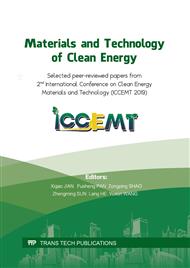[1]
Munoz-Shuguli, C., et al., Cetylpyridinium bromide-modified montmorillonite as filler in low density polyethylene nanocomposite films. Applied Clay Science, 2019. 168: pp.203-210.
DOI: 10.1016/j.clay.2018.10.020
Google Scholar
[2]
Luo, M., et al., Influence of Polymer Coated Montmorillonite Single Layers on the Properties of HNBR Composites. Polymer Materials Science & Engineering, 2017. 33(10): pp.23-28.
Google Scholar
[3]
He, H., et al., Organoclays prepared from montmorillonites with different cation exchange capacity and surfactant configuration. Applied Clay Science, 2010. 48(1): pp.67-72.
DOI: 10.1016/j.clay.2009.11.024
Google Scholar
[4]
Benali, S., et al., Study of Interlayer Spacing Collapse During Polymer/Clay Nanocomposite Melt Intercalation. Journal of Nanoscience & Nanotechnology, 2008. 8(4): p.1707.
DOI: 10.1166/jnn.2008.020
Google Scholar
[5]
Jang, J.S. and S.-D. Yeo, Adsorption of Ethylbenzene and Tetrachloroethylene Using Natural and Organically Modified Clays. Separation Science, 2015. 50(4): pp.573-582.
DOI: 10.1080/01496395.2014.956758
Google Scholar
[6]
Cruz-Guzmán, M., et al., Heavy Metal Adsorption by Montmorillonites Modified with Natural Organic Cations. Soil Science Society of America Journal, 2006. 70(1): p.215.
DOI: 10.2136/sssaj2005.0131
Google Scholar
[7]
Zeng, Q.H., et al., Clay-Based Polymer Nanocomposites: Research and Commercial Development. Journal of Nanoscience & Nanotechnology, 2005. 5(10): pp.1574-92.
Google Scholar
[8]
Wang, Y., et al., Recent progress in luminescent materials based on lanthanide complexes intercalated synthetic clays. Journal of Rare Earth, (2019).
DOI: 10.1016/j.jre.2018.09.004
Google Scholar
[9]
Mousa, M., et al., Clay nanoparticles for regenerative medicine and biomaterial design: a review of clay bioactivity. Biomaterials, 2018. 159: p.204.
DOI: 10.1016/j.biomaterials.2017.12.024
Google Scholar
[10]
Tao, Q., et al., Silylation of Layered Double Hydroxides via a Calcination? Rehydration Route. Langmuir the Acs Journal of Surfaces & Colloids, 2010. 26(4): p.2769.
DOI: 10.1021/la902812g
Google Scholar
[11]
Su, L., et al., Silylation of montmorillonite surfaces: Dependence on solvent nature. Journal of Colloid & Interface Science, 2013. 391(2): pp.16-20.
DOI: 10.1016/j.jcis.2012.08.077
Google Scholar
[12]
Alves, J.L., P.d.T.V.e. Rosa, and A.R. Morales, A comparative study of different routes for the modification of montmorillonite with ammonium and phosphonium salts. Applied Clay Science, 2016. 132-133: pp.475-484.
DOI: 10.1016/j.clay.2016.07.018
Google Scholar
[13]
Reyes and L. Q. Morphology and Structure of Amino Fatty Acid Intercalated Montmorillonite. (2018).
Google Scholar
[14]
Tao, E., et al., Nano-montmorillonite-based porous material prepared by gel casting: structure and adsorption properties. Iet Micro & Nano Letters, 2018. 13(3): pp.332-334.
DOI: 10.1049/mnl.2017.0531
Google Scholar
[15]
Bergaya, F. and G. Lagaly, Chapter 1 General Introduction: Clays, Clay Minerals, and Clay Science. Developments in Clay Science, 2006. 1(05): pp.1-18.
DOI: 10.1016/s1572-4352(05)01001-9
Google Scholar
[16]
Barama, S., Catalytic properties of Rh, Ni, Pd and Ce-containing Aluminium-pillared clays in dry reforming of methane. Catalysis Today, 2009. 141(3): pp.385-392.
DOI: 10.1016/j.cattod.2008.06.025
Google Scholar
[17]
Ghadge, A.N. and M.M. Ghangrekar, Development of low cost ceramic separator using mineral cation exchanger to enhance performance of microbial fuel cells. Electrochimica Acta, 2015. 166: pp.320-328.
DOI: 10.1016/j.electacta.2015.03.105
Google Scholar
[18]
Feng, S.S., et al., Poly(lactide)–vitamin E derivative/montmorillonite nanoparticle formulations for the oral delivery of Docetaxel. Biomaterials, 2009. 30(19): pp.3297-3306.
DOI: 10.1016/j.biomaterials.2009.02.045
Google Scholar
[19]
Shirzad-Siboni, M., et al., Preparation, characterization and application of a CTAB-modified nanoclay for the adsorption of an herbicide from aqueous solutions: Kinetic and equilibrium studies. Comptes Rendus Chimie, 2015. 18(2): pp.204-214.
DOI: 10.1016/j.crci.2014.06.004
Google Scholar
[20]
Zhang, Z., et al., Synergistic effect of cationic and anionic surfactants for the modification of Ca-montmorillonite. Materials Research Bulletin, 2013. 48(5): pp.1811-1816.
DOI: 10.1016/j.materresbull.2013.01.029
Google Scholar
[21]
Rezaie, M. and V. Haddadi-Asl, Effect of chemical components of emulsion polymerization in aqueous media on Na-MMT nanostructure by XRD analysis. Journal of Polymer Research, 2010. 17(3): pp.309-313.
DOI: 10.1007/s10965-009-9317-4
Google Scholar
[22]
He, H., et al., Grafting of swelling clay materials with 3-amino-propyltriethoxysilane. 2005. 288(1): pp.171-176.
Google Scholar
[23]
Li, Y., et al., Preparation and characterization of APTES modified magnetic MMT capable of using as anisotropic nanoparticles. Applied Surface Science, 2018. 447: pp.393-400.
DOI: 10.1016/j.apsusc.2018.03.230
Google Scholar
[24]
Zheng, X., et al., Removal of Cs from water and soil by ammonium-pillared montmorillonite/Fe3O4 composite. Journal of Environmental Sciences, 2017. 56(6): pp.12-24.
DOI: 10.1016/j.jes.2016.08.019
Google Scholar
[25]
Zhang, Y., et al., Identification of Selective Inhibitors for Human Neur-aminidaseIsoenzymes Using C4,C7-Modified 2‑Deoxy-2,3- N‑acetylneuraminic Acid (DANA) Analogues. Journal of Medicinal Chemistry, 2013. 56(7): pp.2948-2958.
DOI: 10.1021/jm301892f
Google Scholar
[26]
Yuan, P., et al., Organosilane functionalization of halloysite nanotubes for enhanced loading and controlled release. Nanotechnology, 2012. 23(37): p.375705.
DOI: 10.1088/0957-4484/23/37/375705
Google Scholar


